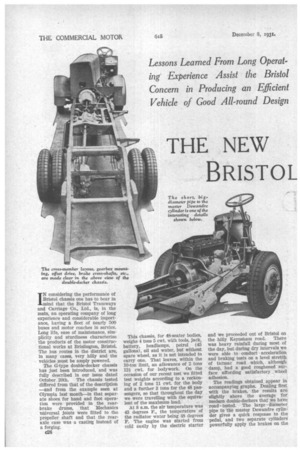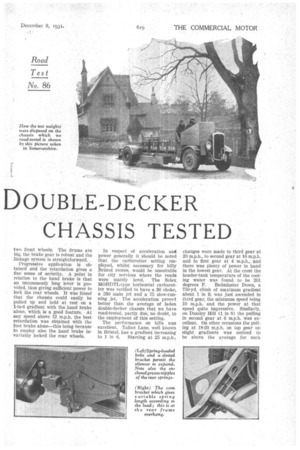THE NEW BRISTOL DOUBLE-DECKER CHASSIS TESTED
Page 48

Page 49

Page 50

If you've noticed an error in this article please click here to report it so we can fix it.
Lessons Learned From Long Operat ing Experience Assist the Bristol Concern in Producing an Efficient Vehicle of Good All-round Design
IN considering the performance of Bristol chassis one has to bear in mind that the Bristol Tramways and Carriage Co., Ltd., is, in the main, an operating company of long experience and considerable importance, having a fleet of nearly 500 buses and motor coaches in service. Long life, ease of maintenance, simplicity and sturdiness characterize the products of the motor constructional works at Brislington, Bristol. The bus routes in the district are. in many cases, very hilly and the vehicles must be amply powered.
The G-type double-decker chassis has just been Introduced, and was fully described in our issue dated October 20th. The chassis tested differed from that of the description —and from the example seen at Olympia last month—in that separate shoes for hand and foot operation were provided in the rearbrake drums, that Mechanics universal joints were fitted to the propeller shaft and that the rearaxle case was a casting instead of a forging.
026 This chassis, for 48-seater bodies, weighs 4 tons 5 cwt. with tools, jack, battery, headlamps, petrol (45 gallons), oil and water, but without spare wheel, as it is not intended to carry one. That leaves, within the 10-ton limit, an allowance of 2 tons 12i cwt. for bodywork. On the occasion of our recent test we fitted test weights according to a reckoning of 2 tons 11 cwt. for the body and a further 3 tons for the 48 passengers, so that throughout the day we were travelling with the equivalent of the maximum load.
At 8 a.m. the air temperature was 43 degrees F., the temperature of the radiator water being 48 degrees F. The engine was started from cold easily by the electric starter and we proceeded out of Bristol on the hilly Keynsham road. There was heavy rainfall during most of the day, but during dry intervals we were able to conduct acceleration and braking tests on a level stretch of tarmac road which, although damp, had a good roughened surface affording satisfactory wheel adhesion.
The readings obtained appear in accompanying graphs. Dealing first with the brakes, the results are slightly above the average for modern double-deckers that we have road tested. The large diameter pipe to the master Dewandre cylinder gives a quick response to the pedal, and two separate cylinders powerfully apply the brakes on the two front wheels. The drums are big, the brake gear is robust and the linkage system is straightforward.
Progressive application is obtained and the retardation gives a fine' sense of security. A point in relation to the hand brake is that an uncommonly long lever is provided, thus giving sufficient power to lock the rear wheels. It was found that the chassis could easily, be pulled up and held at rest on a 1-in-f3 gradient with the hand brake alone, which is a good feature. At any speed above 12 m.p.h. the best retardation was obtained with the foot brake alone—this being because to employ also the hand brake invariably locked the rear wheels.
In respect of acceleration and power generally it should be noted that the carburetter setting employed, whilst necessary for hilly Bristol routes, would be unsuitable for city services where the roads were mainly level. The Solex MOFIDTL-type horizontal carburetter was verified to have a 36 choke, a 230 main jet and a 75 slow-running jet. The acceleration proved better than the average of laden double-decker chassis that we have road-tested, partly due, no doubt, to the employment of this setting.
The performance on hills was excellent. Talbot Lane, well known in Bristol, has a gradient increasing to 1 in 6. Starting at 25 m.p.h., changes were made to third gear at 20 m.p.h., to second gear at 10 m.p.h. and to first gear at 4 m.p.h., and there was plenty of power in hand in the lowest gear. At the crest the header-tank temperature of the cooling water was found to he 201 degrees F. Bedminster Down, a 750-yd. climb of maximum gradient about 1 in 9, was just ascended in third gear, the minimum speed being 10 m.p.h. and the power at that speed quite impressive. Similarly, on Dundry Hill (1 in 8) the pulling in second gear at 6 m.p.h. was excellent. On other occasions the pulling at 18-20 m.p.h. on top gear up slight gradients was noticed to be above the average for such machines. It was necessary at slow engine speeds to make full use of the ignition control.
The " power " setting of the carburetter, as normally employed by the Bristol concern for hilly routes, naturally had its effect upon fuel consumption, a reading of 4.206 m.p.g. being obtained over a stretch of hilly route on which, to resemble bus service, three stops per mile were made. On a less hilly route a straight run made by the Bristol company has yielded 4.95 m.p.g., and, with a 34 carburetter choke and 195 main jet, 5.55 m.p.g. has been obtained. All these readings relate to chassis with the standard 7.6-to-1 final-drive ratio ; a still better figure would be attained with a higher ratio such as a bus company might employ for level routes.
The Alarles steering gear and the tapered-rollerbearings of the stubaxle king-pins give a particularly easy steering, the ratio of which has been well chosen for doubledecker duty, not forgetting the frequency with which city buses have
to pull away from the kerb around obstructing vehicles.
The suspension was found to be in every way satisfactory, the variable-length springs, which are the subject of a Bristol patent, giving shock absorption without lateral instability. One has to make allowance for the fact that the test loads were carried low on the frame, and that the top weight of a double decker severely tries any springing system, but we were able to subject the chassis to exhaustive trials which would have revealed any tendency to side-roll, bounce, pitching or other defects. Incidentally, the rear ends a the springs are enclosed to preserve the longitudinal location of the axle should a main leaf break.
Silence of the transmission, also ease and quietness of gear and clutch control, call for favourable comment. The Bristol gearbox is a
90 100 separate unit mounted in the frame on rubber blocks, which insulate it to some extent, whilst incidentally rendering It a simple matter to drop the gearbox for overhaul.
In this respect other features of accessibility are noticed which affect the maintenance engineer. The radiator is mounted upon a front cross tube, which can be removed so that the engine may be withdrawn from the frame.
Regarding the side-valve 110 b.h.p. power unit, it may be noted that there is no pump to assist circulation of the cooling water, but the cooling system has pipes of ample capacity, and there is a large fan driven by the triple front-end chain through a friction clutch. Lagging of the exhaust pipe with asbestos has been abandoned in favour of employing draught cowling around the manifold and the main lead.
The two frame-side groups of lubrication nipples are accessible and, for cleanliness, are enclosed In neat boxes. A third group, also enclosed, is located on the rear axle.
In conclusion, road work with the Bristol G-type chassis shows it to be a double-decker model of ample power and smoothness of operation, easily controlled and admirably braked, in which the outcome of long operating experience has contributed several good features of design out of consideration for the maintenance engineer.














































































































